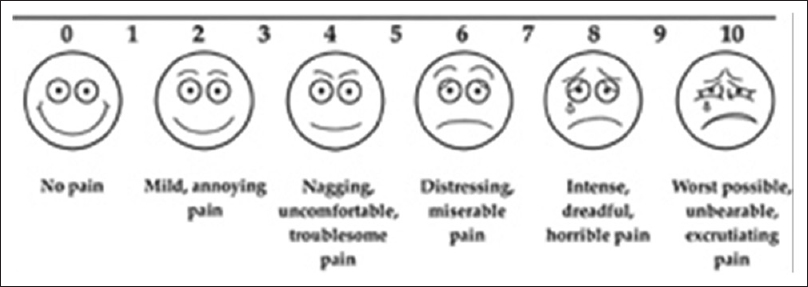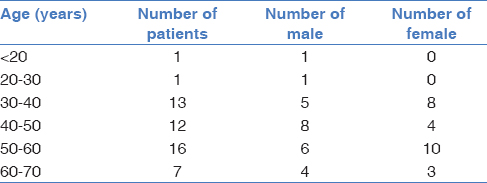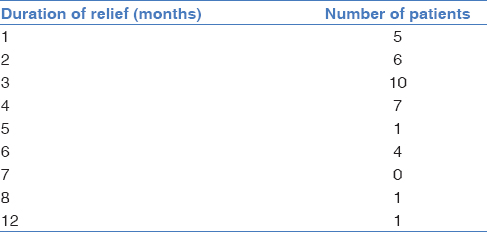Translate this page into:
Role of transforaminal epidural steroid injection in chronic disc pain
Address for correspondence: Dr. Jaganath Karunakaran, Department of Orthopedics, Saveetha Medical College, Saveetha Nagar, Thandalam, Chennai - 602 105, Tamil Nadu, India. E-mail: jaagaa11@gmail.com
-
Received: ,
Accepted: ,
This article was originally published by Wolters Kluwer - Medknow and was migrated to Scientific Scholar after the change of Publisher.
How to cite this article: Parasuraman M, Karunakaran J, Duvvuru A, Shanmugam N. Role of transforaminal epidural steroid injection in chronic disc pain. J Orthop Spine 2020;8:12-5.
Abstract
BACKGROUND:
Chronic lower back pain is a chronic pain syndrome in the lower back region lasting for ≥12 weeks with the most common cause being intervertebral disc herniation. Epidural steroid injection is the most widely accepted treatment modality of all the surgical and non surgical methods at various sites such as translaminar, caudal, and transforaminal. It is ideal to start transforaminal epidural steroid injection (TFESI) early as chronic neural compression leads to irreversible changes in neural anatomy, which leads to a less favorable outcome.
AIMS AND OBJECTIVES:
To study the effectiveness of TFESI in chronic disc pain with radiculopathy in terms of duration of relief.
MATERIALS AND METHODS:
This is a retrospective study involving 50 patients with chronic disc pain who underwent fluoroscopic guidance TFESI in the year 2018 at Saveetha medical college. These patients are those who were administered TFESI under fluoroscopic guidance using 2ml of 40mg of Methylprednisolone with 1 ml of 2% xylocaine. Their initial pre injection and current pain scores were assessed using a visual analog scale (VAS score) by recording the medical history and follow-up, respectively.
RESULTS:
The most common level of involvement was L4/L5 (80%). The mean difference in VAS score was 3.14. The standard deviation of the mean difference in VAS score (σ) is 1.38. The mean duration of relief is 2.5 months. Around 14% (7 patients) did not have any relief in pain after the procedure. Around 76% of the patients were willing to recommend the procedure to others with a similar problem. Two individuals underwent surgery following the procedure, which suggests a failure of the procedure.
CONCLUSION:
TFESI is a very useful procedure for significant pain reduction in chronic disc pain involving a single level. In addition to corticosteroids, lignocaine is very useful in reducing local inflammation and pain due to its “washout effect.” Hence, TFESI with postoperative strengthening exercises is beneficial for short-term pain relief.
Keywords
Fluoroscopic-guided injection
radiculopathy
transforaminal epidural steroid injection
Introduction
Low back pain is an important clinical, social, economic, and public health problem affecting the population indiscriminately. It is a disorder with many possible etiologies, occurring in many groups of the population, and with many definitions.[1] Chronic lower back pain is a chronic pain syndrome in the lower back region, which has been lasting for ≥12 weeks. Many authors suggest defining chronic pain as pain that lasts beyond the expected period of healing, avoiding this close-time criterion.[2] The most common cause of the radicular pain and lower extremity pain is the herniated intervertebral disc which induces pressure over the nerve root resulting in pain and functional disability. Multiple modalities of treatment are present, both surgical and nonsurgical, of which epidural steroid injection is used in the treatment of low backache.[3] and is now the widely accepted principal modality for back pain with signs of nerve root irritation.
An epidural steroid injection can be administered in various modes such as translaminar, caudal, and transforaminal. In the transforaminal route, the site of injection is through foramen between the vertebra through which nerve roots exit. It provides good relief in chronic low back pain with radiculopathy.[4,5] In the translaminar approach, the site of injection is the space between the laminae of adjacent vertebrae. In this approach, the injected material disperses over a greater area, and so this type of injection is commonly used for bilateral or multilevel symptoms. It is ideal to start transforaminal epidural steroid injection (TFESI) early as chronic neural compression leads to irreversible changes in neural anatomy, which leads to a less favorable outcome in patients with ≥12 months of symptoms duration.[6]
Aim
To study the effectiveness of TFESI in chronic disc pain with radiculopathy.
To determine the mean duration of relief offered by TFESI in chronic disc pain with radiculopathy.
Materials and Methods
This is a retrospective study involving 50 patients who had undergone TFESI in the year 2018 at Saveetha Medical College after obtaining approval from the review board. A total of 25 males and 25 females were included in the study. The objective of the study is to evaluate the improvement in pain among patients with chronic disc pain treated with TFESI to know the incidence of adverse events and failure.
Inclusion criteria
Low back pain radiating to one lower limb
Duration of pain >3 months and less than a year duration
No improvement in symptoms even after 3 months of conservative management and physiotherapy
Intervertebral disc prolapse present at one level radiologically in magnetic resonance imaging.
Exclusion criteria
Patients with multilevel degenerative spine disease
Patients with spondylolisthesis (>Grade 1)
Patients with previous lumbar surgery
Patients suffering from neurologic conditions such as cauda equina syndrome, arachnoiditis, and progressive neurologic deficit
Patients allergic to the myelography contrast, steroid, and local anesthetic agent
Patients not willing to participate.
Procedure
The patients were prepared with 6 h of fasting. Blood pressure, electrocardiogram, and pulse oximetry were routinely monitored. Peripheral intravascular cannulation was established, and Ringer's lactate solution was started slowly. All patients received antibiotic ceftriaxone 1 g. The patients were placed on the intervention table in prone position. Antiseptic dressing (povidone-iodine scrub and painting) and draping were done, and images of the site were taken under fluoroscopy. The injection site was then marked with a radio-opaque marker after proper squaring of the vertebra in the anteroposterior view. The site was then infiltrated with 5 ml of 1% lignocaine and adrenaline. A 22G 9-cm needle was directed under fluoroscopic guidance just below the pedicle along the ventral aspect of an intervertebral foramen in the lateral view. A volume of 2 ml of iohexol was injected through the needle via an extension cord to confirm the epidural space. Without changing the position of the needle, a 3 ml solution comprising 2 ml of methylprednisolone (40 mg/ml) and 1 ml of 2% lignocaine was injected through the needle on both sides of the same level to dilute the contrast. The patients were then shifted to the recovery room. Hemodynamic monitoring was done until 1 h after the intervention. Once the pain relief was obtained postoperatively, physiotherapy in the form of isometric spine exercises, spinal extension exercises, and core-strengthening exercises was given. The initial preinjection and current pain scores were assessed using a visual analog scale (VAS score) as in Figure 1 by recording the medical history and follow-up, respectively. The patient's VAS score was assessed after duration of 6 months from the procedure.

- Visual analog scale score
Statistical analysis
The VAS score was analyzed by determining the mean, median, mode, and standard deviation and by Wilcoxon signed-rank test.
Results
A total of 50 patients (25 females and 25 males) were enrolled in the study [Table 1]. All these patients experienced chronic low back pain radiating to a unilateral lower limb and suffered from neurogenic claudication. The mean age of the patients was 47.2 years. The mean duration of symptoms before the intervention was 6 months. The most common level of involvement was L4/L5 (80%) [Table 2]. The improvement in the VAS score is shown in Table 3. The mean difference in VAS score was 3.14. The standard deviation of the mean difference in VAS score (σ) is 1.38. The mean duration of relief is 2.5 months [Table 4]. Around 14% (7 patients) did not have any relief in pain after the procedure. Around 76% of the patients were willing to recommend the procedure to others with a similar problem. Two individuals underwent surgery following the procedure, which suggests a failure of the procedure.




Wilcoxon signed-rank test
The test statistic T = min {W+, W−} = min {946, 0}
Zc= 1.96
Z-statistic = −5.711
| Zc | > Zc. Thus, the null hypothesis (i.e., there is no association between TFESI and the relief of pain) can be rejected.
Mean (W): 473
Standard deviation (W): 82.82.
Discussion
Chronic low back pain often radiates to hips and legs which are aggravated on the day to day activities such as walking, sitting, lifting weights, etc., Chronic pain is triggered by multiple mechanisms such as noxious stimulation and nociception, which sensitize the pain pathway. Calcitonin gene-related peptide and substance P have been proven to have a causative role. The excess neurotransmitter release is responsible for hyperalgesia. Discs partly composed of cartilage are prone to wear and tear with advancing age due to water and protein changes, which leads to subsequent inflammation. Corticosteroid has different modalities of action in reducing pain. These are membrane stabilization, blockade of phospholipase A2, inhibition of synthesis or release of pro-inflammatory substances, suppression of sensitization of dorsal horn neurons, and reversible local anesthetic effect.[7,8,9]
In a study done by Rosenberg et al., it was observed that TFESIs could offer significant pain reduction up to 1 year after the initiation of treatment in patients with discogenic pain and possibly in patients with spinal stenosis.[10] Botwin et al. observed that fluoroscopically guided TFESIs may help to reduce the radicular pain and improve standing and walking tolerance in patients with degenerative lumbar spinal stenosis.[11]
Ghahreman et al. conducted a study done to assess the efficacy of lumbar TFESI for radicular pain secondary to disc herniation.[12] There was ≥50% relief of pain in about 54% of patients after 1 month after treatment, and the results were significant as compared to other modalities of treatment. Twenty-five percent of patients undergoing LTFESI had relief persisting for at least 12 months, without repeat treatment. There was also restoration of function.
In this study, there is a statistically significant reduction in pain scores. The symptoms were relieved better on a short-term basis when compared to preinjection levels. There were no catastrophic complications such as a dural tear, permanent neurological deficits, or loss of vision following the procedure that were encountered, and the reason being an appropriate visualization of the position of the needle in C arm, confirmation by injection of contrast, and the use of extension cords to prevent the change of position of the needle while injecting the steroid. Seven patients had no relief in pain following the procedure. Two patients had to undergo surgery following the procedure. Two patients complained of pain at the site of injection for the initial few days; this might be probably due to the volume of drug injected into the tight space or may be due to the additive.
Conclusions
TFESI is a very useful procedure for significant pain reduction in chronic disc pain involving a single level. In addition to corticosteroids, lignocaine is very useful in reducing local inflammation and pain due to its “washout effect.”[13,14,15] No significant complications were recorded. Thus, TFESI with postoperative strengthening exercises is beneficial for short-term pain relief. However, this being a short-term and retrospective study, it is not possible to assess the period at which the peak improvement occurred, the lasting effect of pain relief, and the recurrence of pain. A long-term prospective study with periodic follow-up would be beneficial. Furthermore, a larger sample size involving patients representing various parts would help in arriving at a generalized conclusion.
Financial support and sponsorship
Nil.
Conflicts of interest
There are no conflicts of interest.
References
- Epidemiology of low back pain in Indian population: A review. Int J Basic Applied Med Sci. 2015;5:166-7.
- [Google Scholar]
- Mechanisms of low back pain: A guide for diagnosis and therapy. F1000Res. 2016;5 pii: F1000 Faculty Rev-1530
- [CrossRef] [Google Scholar]
- Lumbar transforaminal epidural steroid injection in patients with lumbar radicular pain; Outcome results of 2-year follow-up. Bull Emerg Trauma. 2019;7:144-9.
- [CrossRef] [PubMed] [Google Scholar]
- A critical review of the American Pain Society clinical practice guidelines for interventional techniques: Part 1. Diagnostic interventions. Pain Physician. 2010;13:E141-74.
- [CrossRef] [Google Scholar]
- The use of lumbar epidural/transforaminal steroids for managing spinal disease. J Am Acad Orthop Surg. 2007;15:228-38.
- [CrossRef] [PubMed] [Google Scholar]
- A study of transforaminal epidural steroid injections in patients with lumber disc herniation. Int J Res Med Sci. 2015;3:3853-7.
- [CrossRef] [Google Scholar]
- Neurogenic hyperalgesia: Psychophysical studies of underlying mechanisms. J Neurophysiol. 1991;66:190-211.
- [CrossRef] [PubMed] [Google Scholar]
- Effect of local methylprednisolone on pain in a nerve injury model. A pilot study. Reg Anesth. 1997;22:59-65.
- [CrossRef] [PubMed] [Google Scholar]
- Do corticosteroids produce additional benefit in nerve root infiltration for lumbar disc herniation? Spine (Phila Pa 1976). 2008;33:743-7.
- [CrossRef] [PubMed] [Google Scholar]
- Effectiveness of transforaminal epidural steroid injections in low back pain: A one year experience. Pain Physician. 2002;5:266-70.
- [CrossRef] [PubMed] [Google Scholar]
- Fluoroscopically guided lumbar transformational epidural steroid injections in degenerative lumbar stenosis: An outcome study. Am J Phys Med Rehabil. 2002;81:898-905.
- [CrossRef] [PubMed] [Google Scholar]
- The efficacy of transforaminal injection of steroids for the treatment of lumbar radicular pain. Pain Med. 2010;11:1149-68.
- [CrossRef] [PubMed] [Google Scholar]
- Local corticosteroid application blocks transmission in normal nocioceptive C-fibers. Acta Anesthesiol Scand. 1990;34:335-8.
- [CrossRef] [PubMed] [Google Scholar]
- High levels of inflammatory phospholipase A2 activity in lumbar disc herniations. Spine (Phila Pa 1976). 1990;15:674-8.
- [CrossRef] [PubMed] [Google Scholar]
- Efficacy of epidural steroid injection in lumbar disc disease. Int J Orthopaed Sci. 2018;4:1-5.
- [CrossRef] [Google Scholar]






